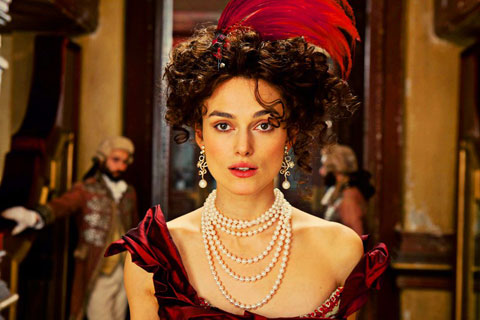A new film version of Tolstoy’s Anna Karenina (and Sean Baker’s Starlet)
By Joanne Laurier
22 December 2012
Anna Karenina, directed by Joe Wright, screenplay by Tom Stoppard, based on the novel by Leo Tolstoy; Starlet, directed by Sean Baker, screenplay by Baker and Chris Bergoch
 Anna Karenina
Anna KareninaBritish filmmaker Joe Wright’s Anna Karenina is the latest cinematic adaption of the classic novel, published in installments from 1873 to 1877, by Leo Tolstoy (1828-1910).
Collaborating with playwright-scriptwriter Tom Stoppard, Wright (Pride and Prejudice [2005], Atonement [2007]), in an unusual twist, has chosen to stage much of the film’s action under the proscenium arch of a gas-lit theater.
In late 19th century Russia, Tolstoy’s heroine Anna Karenina (Keira Knightley) is married to pompous tsarist government official Karenin (Jude Law). As the film opens, Anna has been called to Moscow from her home in St. Petersburg by her brother Oblonsky (Matthew Macfadyen), whose marriage to Dolly (Kelly Macdonald) is in crisis due to his chronic philandering. On the night train, Anna meets Countess Vronsky (Olivia Williams), and soon after, her son, the dashing cavalry officer, Count Vronsky (Aaron Taylor-Johnson).
The thunder-bolt attraction between Anna and Vronsky leads to an illicit affair, its intensity a measure of the former’s previous deep unhappiness and emotional suffocation. When she leaves Karenin for her lover, Anna becomes a social pariah. This fate differs markedly from that of her brother, who suffers only minor repercussions for his libertinage. And, despite his extra-marital liaison, Vronsky is able to move freely in Russian society, while Anna remains isolated and shunned, a dynamic that has tragic consequences.
A parallel story unfolds concerning Levin (Domhnall Gleeson), a country landowner, who pursues and marries Kitty (Alicia Vikander), sister to the long-suffering Dolly. Levin functions as the film’s moral compass. His simple lifestyle and monogamy are counterposed to the ostentatious trappings of the urban social set and its hypocritical double standard, which allows for breaking the law but not the rules.
Stoppard’s screenplay is an intelligent distillation of the Tolstoy novel. And given that there have been more than a dozen versions of the book filmed since 1914, including three made in the Soviet Union, in addition to various stage, television and radio productions and also looser adaptations (among them, a 2007 film interpretation from Kazakhstan), it is understandable that Wright would want to put his own stamp on the project.
He does so by corseting the drama within a stage set. In this claustrophobic space, actors, musicians, props and painted backdrops vie for the camera’s attention. This confinement occasionally opens up to the outside world, a transition used to highlight the difference between the untainted countryside and the cramped, dissolute city. The theatrical mechanism has a certain visual appeal, but it also underscores serious misconceptions regarding Tolstoy on Wright’s part.
In the first place, the artifice of the stage device tends to work in the opposite direction from Tolstoy, an arch-realist who drew incomparable pictures of Russian society by forthrightly “removing the veils” from life. This is a point worth considering for a moment. One of the greatest commentators on Tolstoy, Aleksandr Voronsky, wrote in On Art (1925):
“The realist writer [i.e., Tolstoy] does not dream up, invent or create fantastic worlds; he doesn’t engage in free play of the imagination, nor does he seek embellishments for their own sake. It is as if he were reading the secret code inherent in things, people and events. The goal of the artist is not to describe or tell a story masterfully and wonderfully. …
“There is no need to confuse the artist’s special gift of insight with the desire to strike the reader by producing a beautiful turn of phrase, a special style, or a totally new work of art. Such a desire usually leads to pretentiousness, deliberate overrefinement, excessive floweriness and artificiality. … Many contemporary poets and prose-writers commit this sin. They confuse the ability of the artist to see what no one else has seen with a desire to astound the reader.” This reads almost word for word like a criticism of Wright’s gimmickry.
Furthermore, the director’s deliberate reduction of space tends to stunt the movie’s dramatic flow, and hinders the psychological development of its protagonists. The characters, so beautifully drawn by Tolstoy, are severely truncated in the film, functioning as relatively impoverished figures. Much is sacrificed on the altar of Wright’s innovations.
In seeking to explain his artistic decisions, the filmmaker says in an interview that “the action would be taking place within a beautiful decaying theatre, which in itself would be omnipresent, a metaphor for a society of the time as it rotted from the inside.” (Apparently, it took some convincing to bring Stoppard on board with Wright’s vision.)
However, Russian society was not just decaying, it was also moving headlong towards a cataclysm, a fact artistically anticipated by Tolstoy. In a 1908 article (“Leo Tolstoy as the Mirror of the Russian Revolution”), Lenin described the great writer as offering protests against “social falsehood and hypocrisy,” “merciless criticism of capitalist exploitation” and the “unmasking of the profound contradictions between the growth of wealth and achievements of civilization and the growth of poverty, degradation and misery among the masses.”
Lenin also refers to Tolstoy’s weak side, his role as “the crackpot preaching of submission, ‘resist not evil’ with violence” and promoter “of one of the most odious things on earth, namely, religion.”
Unfortunately, the film treats the novel and its events ahistorically and therefore neither Tolstoy’s strengths nor his weaknesses are essentially considered—or understood—by the filmmakers.
Instead, Wright, together with a number of film critics, proclaims that Tolstoy’s major theme in Anna Karenina is love. Speaking about the character Levin, Wright says: “I think he’s the character in the end who kinda gets it right, and therefore he’s the character that I aspire to ... I find bits of me in all of them. Anna confuses that initial sexual love for being true love; well, I’ve done that. And like Oblonsky, I’ve been greedy with love. And also like Karenin, I’ve been the cuckold in love. So I think it’s an expression of many different sides of us.” The film’s flamboyant design cannot conceal the threadbare and, frankly, self-involved character of these conceptions.
Wright’s interpretation has little to do with Tolstoy. If there is a connection, it is only to secondary or tertiary aspects of the book. In fact, the director employs a good deal of film bombast to cover up the limitations of his views. This perhaps accounts for the fact that although the actors try hard and bring to bear considerable talent and skill, no characterization is genuinely full-dimensional or Tolstoyesque.
Macfadyen as Oblonsky is amusing, but not quite on point; Macdonald, as his wife Dolly, gets overrun by the film’s hurried pace and pulsating props (by contrast, Trotsky: “In his work Tolstoy is as unhurried as the life he pictures”); Law as Karenin tries to maintain a modicum of dignity with an understated performance, presumably to offer a respite from the frantic goings-on.
Ralph Richardson as Karenin in the 1948 film version (directed by Julien Duvivier, written in part by Jean Anouilh and produced by Alexander Korda) was terrifyingly bloodless as the officious state administrator and unforgiving moralist. There was some correspondence between his performance and Tolstoy’s creation, who thinks to himself, “My aim is simply to safeguard my reputation, which is essential for the uninterrupted pursuit of my public duties.” Further describing Karenin’s obsession with social status, Tolstoy goes on: “An attempt at divorce could lead to nothing but a public scandal, which would be a perfect godsend to his enemies for calumny and attacks on his high position in society.”
Knightley as Anna is often painful to watch, as she grimaces her way through too much of the movie. Despite her obviously serious effort, lost in her performance for the most part is Tolstoy’s notion that Anna’s descent into madness is fundamentally socially driven. Nor does Taylor-Johnson as Vronsky properly pin down the part his character plays in Anna’s horrible torment, whose ultimate source is the mendacity and chicanery of his social milieu.
It is to his credit that Wright took on Tolstoy, a decision that bucks current trends. Unfortunately, however, the manner in which he approached the project—without thinking things through to the end, desiring to impress, socially indifferent—reflects too much of the current atmosphere in the film industry.
Starlet
Written and directed by Sean Baker, Starlet tells the story of 21-year-old Jane (Dree Hemingway—daughter of Mariel and great-granddaughter of Ernest), who forms a relationship with the elderly Sadie (Besedka Johnson) in California’s San Fernando Valley. Starlet, in fact, is the name of Jane’s pampered Chihuahua.
 Starlet
StarletJane is looking for a mother figure, while Sadie lacks a daughter (hers has died). The two meet when Sadie is forced by local officials to unclutter her home and holds a yard sale. The thermos Jane buys from her, however, contains a stash of money.
After unsuccessfully trying to tell Sadie about her find, Jane settles into a routine that involves taking the older woman grocery shopping and to bingo. The conceit of this pedestrian plotline is that Jane happens to be a successful porn star. The filmmakers let it prominently be known that adult film actor Zoe Voss served as a consultant.
Starlet is chilly, superficial and unpleasant. In interviews, Baker asserts that his film was inspired in part by the French New Wave, Italian neorealism and British social realism. The movie does not show much evidence of the better part of that heritage. Baker’s inclusion of Lars von Trier’s The Idiots, a deplorable, hysterical film, among his favorites is not an encouraging sign, to say the least.
In fact, Starlet is far removed from addressing American life, despite its pretensions. In the end, it accommodates to and apologizes for a debased atmosphere. The work is not made in the spirit of any serious neorealist or realist cinematic school, but seems largely a product of Baker’s narrow and not all that intriguing concerns.





Follow the WSWS